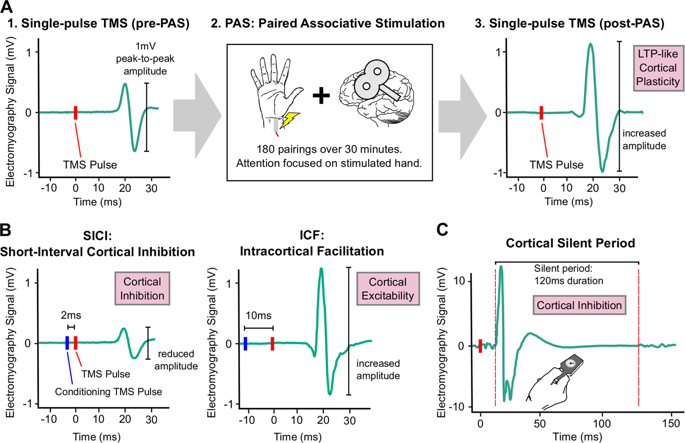当前位置:
X-MOL 学术
›
Neuropsychopharmacology
›
论文详情
Our official English website, www.x-mol.net, welcomes your feedback! (Note: you will need to create a separate account there.)
An inverse relationship between cortical plasticity and cognitive inhibition in late-life depression.
Neuropsychopharmacology ( IF 7.6 ) Pub Date : 2019-05-09 , DOI: 10.1038/s41386-019-0413-9 Jennifer I Lissemore 1, 2 , Hayley R C Shanks 1 , Meryl A Butters 3 , Apoorva Bhandari 1 , Reza Zomorrodi 1 , Tarek K Rajji 1, 2, 4 , Jordan F Karp 3, 5 , Charles F Reynolds 3 , Eric J Lenze 6 , Zafiris J Daskalakis 1, 2, 4 , Benoit H Mulsant 2, 4 , Daniel M Blumberger 1, 2, 4
Neuropsychopharmacology ( IF 7.6 ) Pub Date : 2019-05-09 , DOI: 10.1038/s41386-019-0413-9 Jennifer I Lissemore 1, 2 , Hayley R C Shanks 1 , Meryl A Butters 3 , Apoorva Bhandari 1 , Reza Zomorrodi 1 , Tarek K Rajji 1, 2, 4 , Jordan F Karp 3, 5 , Charles F Reynolds 3 , Eric J Lenze 6 , Zafiris J Daskalakis 1, 2, 4 , Benoit H Mulsant 2, 4 , Daniel M Blumberger 1, 2, 4
Affiliation

|
Executive dysfunction is a common and disabling component of late-life depression (LLD), yet its neural mechanisms remain unclear. In particular, it is not yet known how executive functioning in LLD relates to measures of cortical physiology that may change with age and illness, namely cortical inhibition/excitation and plasticity. Here, we used transcranial magnetic stimulation (TMS) to measure cortical inhibition/excitation (n = 51), and the potentiation of cortical activity following paired associative stimulation, which is thought to reflect long-term potentiation (LTP)-like cortical plasticity (n = 32). We assessed the correlation between these measures of cortical physiology and two measures of executive functioning: cognitive inhibition, assessed using the Delis-Kaplan Executive Function System Color-Word Interference ["Stroop"] Test, and cognitive flexibility, assessed using the Trail Making Test. Correlations with recall memory and processing speed were also performed to assess the specificity of any associations to executive functioning. A significant correlation was found between greater LTP-like cortical plasticity and poorer cognitive inhibition, a core executive function (rp = -0.56, p < 0.001). We did not observe significant associations between cortical inhibition/excitation and executive functioning, or between any neurophysiological measure and cognitive flexibility, memory, or processing speed. Our finding that elevated cortical plasticity is associated with diminished cognitive inhibition emphasizes the importance of balanced synaptic strengthening to healthy cognition. More specifically, our findings suggest that hyper-excitability of cortical circuits following repeated cortical activation may promote inappropriate prepotent responses in LLD. LTP-like cortical plasticity might therefore represent a neural mechanism underlying an inhibitory control cognitive endophenotype of LLD.
中文翻译:

晚期抑郁症中皮质可塑性与认知抑制之间呈反比关系。
执行功能障碍是晚期抑郁症(LLD)的常见和致残因素,但其神经机制仍不清楚。尤其是,尚不了解LLD的执行功能如何与可能随年龄和疾病而变化的皮质生理指标有关,即皮质抑制/激发和可塑性。在这里,我们使用经颅磁刺激(TMS)来测量皮质抑制/激发(n = 51),以及配对联想刺激后皮质活性的增强,这被认为反映了长期增强(LTP)样的皮质可塑性( n = 32)。我们评估了这些皮质生理指标与执行功能的两个指标之间的相关性:认知抑制,使用Delis-Kaplan执行功能系统色词干扰[“ Stroop” ]测试和认知灵活性,使用“追踪制作测试”进行评估。还进行了与回忆记忆和处理速度的关联,以评估与执行功能相关的任何关联的特异性。发现更大的LTP样皮质可塑性与较差的认知抑制(一种核心执行功能)之间存在显着相关性(rp = -0.56,p <0.001)。我们没有观察到皮层抑制/激发与执行功能之间,或任何神经生理学测量与认知柔韧性,记忆力或加工速度之间的显着关联。我们的发现皮质可塑性增高与认知抑制作用减弱有关,这强调了平衡突触增强对健康认知的重要性。进一步来说,我们的发现表明,反复皮层激活后皮层回路的过度兴奋性可能会促进LLD中不适当的特异反应。因此,LTP样皮质可塑性可能代表了LLD抑制性控制认知内表型的神经机制。
更新日期:2019-05-16
中文翻译:

晚期抑郁症中皮质可塑性与认知抑制之间呈反比关系。
执行功能障碍是晚期抑郁症(LLD)的常见和致残因素,但其神经机制仍不清楚。尤其是,尚不了解LLD的执行功能如何与可能随年龄和疾病而变化的皮质生理指标有关,即皮质抑制/激发和可塑性。在这里,我们使用经颅磁刺激(TMS)来测量皮质抑制/激发(n = 51),以及配对联想刺激后皮质活性的增强,这被认为反映了长期增强(LTP)样的皮质可塑性( n = 32)。我们评估了这些皮质生理指标与执行功能的两个指标之间的相关性:认知抑制,使用Delis-Kaplan执行功能系统色词干扰[“ Stroop” ]测试和认知灵活性,使用“追踪制作测试”进行评估。还进行了与回忆记忆和处理速度的关联,以评估与执行功能相关的任何关联的特异性。发现更大的LTP样皮质可塑性与较差的认知抑制(一种核心执行功能)之间存在显着相关性(rp = -0.56,p <0.001)。我们没有观察到皮层抑制/激发与执行功能之间,或任何神经生理学测量与认知柔韧性,记忆力或加工速度之间的显着关联。我们的发现皮质可塑性增高与认知抑制作用减弱有关,这强调了平衡突触增强对健康认知的重要性。进一步来说,我们的发现表明,反复皮层激活后皮层回路的过度兴奋性可能会促进LLD中不适当的特异反应。因此,LTP样皮质可塑性可能代表了LLD抑制性控制认知内表型的神经机制。



























 京公网安备 11010802027423号
京公网安备 11010802027423号